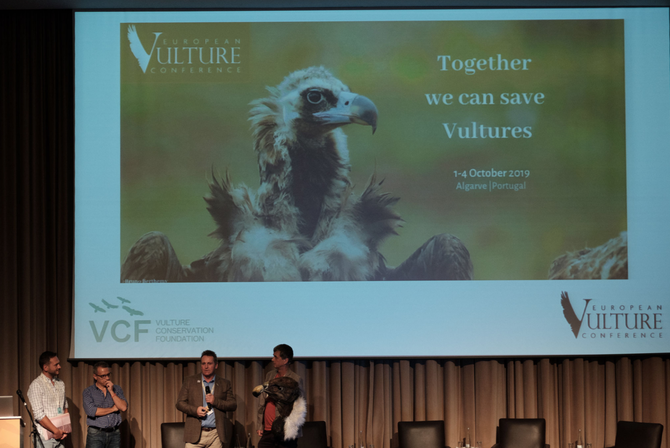
From reintroducing a record of 22 Bearded Vultures into the wild to organising the first European Vulture Conference, this has been a fantastic year for vulture conservation. We have already taken a closer look into the Bearded Vulture, Cinereous Vulture, Griffon Vulture and Egyptian Vulture conservation highlights, and here is an overview of the year.
European Vulture Conference

For four days in October, we brought together scientists, conservationists and the public in the Algarve, Portugal, for an international congress looking at the latest research and conservation of vultures in Europe and beyond, in our first European Vulture Conference. During the European Vulture Conference, we had 72 talks, 34 posters, eight symposia, three field trips, five vulture artists and over 240 participants. For more details, you can have a look at the highlights of the conference on our blog: day one, day two, and day three and field trips.
Captive breeding
We coordinate the Bearded Vulture Captive Breeding Network (EEP) of zoos, specialised breeding centres, recovery centres and private collections. This involves closely working with our colleagues across Europe to ensure the best breeding results from the 178 birds within the Network. The captive breeding season of 2018-2019 was excellent with a new record of 29 fledglings produced within the EEP.
Now the new breeding season is kicking-off, with Bearded Vultures already laying eggs.
Reintroduction-restocking
We are involved in multiple reintroduction-restocking projects to boost local populations across Europe for Bearded Vultures, Griffon Vultures and Cinereous Vultures in different parts of Europe.
Thanks to the great captive breeding season in 2019, we broke another record. We released a total of 22 Bearded Vultures in the wild across 6 sites – two in Baronnies, two in Vercors, five in Grands Causses as part of LIFE GypConnect. As part of other projects, we released nine in Andalusia, two in Corsica, and two in Maestrazgo.

Four captive-bred, and 12 wild-origin (coming from rehabilitation centres in Extremadura, Spain) Cinereous Vultures were released in Bulgaria in a historic milestone for vulture conservation in the Balkans, within the Vultures Back to LIFE project.
Four more Cinereous Vultures were secured from Spain, to be released in the Gorge du Verdon, France.
The VCF secured and transported a total of 62 Griffon Vultures from Spain to Sardinia within the LIFE Under Griffon Wings project that aims to improve the conservation status of the species on the island, fulfilling the requirements of the project.
This year, a new LIFE project was approved and launched in October – LIFE with Vultures. The project aims to preserve the species in Cyprus with one o the actions involving restocking the Griffon Vulture population to the island by transporting birds from Spain.
Tackling threats
We mitigate the threats European vultures face head-on through executing concrete conservation actions, developing action plans and sharing our expertise.
Vultures’ most significant threat worldwide is illegal wildlife poisoning, and we are tackling this with the Balkan Anti-Poisoning Project (BAPP) (funded by the MAVA Foundation), which is working across the Balkan Peninsula to prevent this insidious practice and protect vultures. This year, the project made great strides, developing national strategies against poisoning in 6 countries. We also implemented the BAPP Small Grants Programme funding nine projects from 6 countries with a total budget 60.000. We also brought together wildlife conservation organisations, governmental agencies and other stakeholders
anti-poisoning workshops and several national and joint meetings to help tackle illegal wildlife poisoning.
Monitoring
We closely monitor all of Europe’s vulture species to study and understand their behaviour to help inform more accurate conservation actions, which involves tagging many individuals with GPS tags.
This year, the VCF was involved in equipping a total of 51 vultures with GPS transmitters! 14 Bearded Vultures, 24 Cinereous Vultures, 9 Egyptian Vultures and 4 Griffon Vultures.
Follow the movements of tagged birds by visiting our online public maps.
Research
Apart from following vulture research outputs to inform current and future conservation strategies, our staff and board members are leading scientists shaping vulture conservation research. Have a look at the VCF co-authored publications below.
1.Vulture conservation: the case for urgent action. Safford et al. 2019. Bird Conservation International
2.Spatial and Temporal Variability in Migration of a Soaring Raptor Across Three Continents. Phipps et al. 2019. Frontiers in Ecology and Evolution
3.Navigating spaces for implementing raptor research and conservation under varying levels of violence and governance in the Global South. Santangeli et al. 2019. Biological Conservation
4.Cabo Verde Egyptian Vulture Neophron percnopterus on the brink: community perceptions, inferences and facts of an extreme population crash. Freitas et al. 2019. Bird Conservation International
5.Vultures attacking livestock: A problem of vulture behavioural change or farmers’ perception? Duriez et al. 2019. Bird Conservation International
Learn about the 2019 conservation highlights of the other European vulture species:
Thank you for your continuous support. You can donate to the Vulture Conservation Foundation and help us continue our conservation work, protecting Europe’s vultures.



